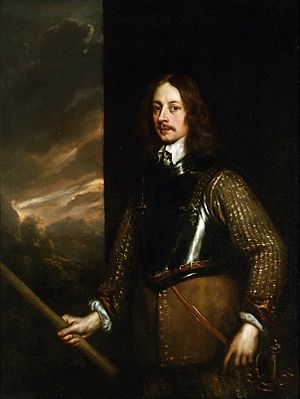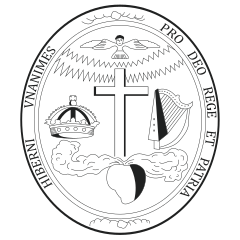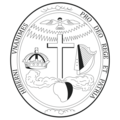Irish Rebellion of 1641 facts for kids
Quick facts for kids Irish Rebellion of 1641 |
|||||||
|---|---|---|---|---|---|---|---|
| Part of the Irish Confederate Wars | |||||||
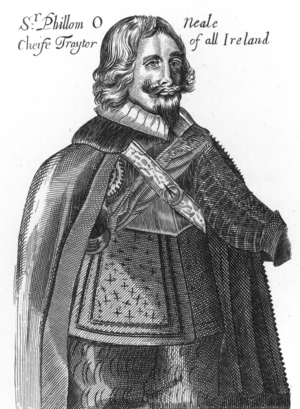 Felim O'Neill of Kinard, a leader of the rebellion |
|||||||
|
|||||||
| Belligerents | |||||||
|
|
|||||||
| Commanders and leaders | |||||||
|
|||||||
The Irish Rebellion of 1641 (Irish: Éirí Amach 1641) was a major uprising in Ireland. It was led by Catholics who wanted an end to unfair rules against them. They also wanted more control over their own government and to get back lands that had been taken from them.
The rebellion started on October 23, 1641. It happened because of problems between King Charles I and his opponents in England and Scotland. The rebels worried that these problems would lead to an invasion of Ireland and even harsher rules against Catholics.
The uprising began as a secret plan by Catholic nobles and army officers. They hoped to take control quickly. But it soon grew into a widespread rebellion and a conflict between different groups of people. This led to the Irish Confederate Wars (1641–1652). During these wars, a large part of the Irish population was affected.
Led by Felim O'Neill, the rebels failed to capture the English government at Dublin Castle. However, within days, they took control of most of Ulster, a northern province. O'Neill then made a fake announcement, claiming King Charles supported their actions. This encouraged many Anglo-Irish Catholics to join the fight. Soon, most of Ireland was in rebellion.
In November, the rebels attacked Drogheda and defeated an English army at Julianstown. At the start of the rebellion, especially in Ulster, thousands of Protestant settlers were killed or forced to leave their homes. The settlers fought back. Events like the Portadown massacre made people in England and Scotland very angry. These events had a lasting impact on the Ulster Protestant community.
Both King Charles and the English Parliament wanted to stop the rebellion. But they did not trust each other to control an army. This disagreement helped cause the First English Civil War in August 1642. The first English troops arrived in Dublin in December 1641. They took back areas around Dublin and Cork.
In March 1642, King Charles approved a law called the Adventurers' Act. This law allowed Parliament to raise money for more soldiers. The money would be paid back by taking land from the rebels. In April, a Scottish army landed in Ulster to protect their fellow Protestants. They quickly took control of eastern Ulster. A local Protestant army, called the Laggan Army, held the northwest. Most of the rest of Ireland was controlled by the rebels.
In May 1642, Ireland's Catholic bishops met in Kilkenny. They said the rebellion was a "just war" and decided to take control of it. With Catholic nobles present, they agreed to form a new government. This was called the Irish Catholic Confederacy. They also created the Confederate Oath of Association. For the next ten years, the Confederates fought a three-sided war. They fought against Irish Protestant Royalists, Scottish Protestants, and English Parliamentarians.
Contents
Why Did the Rebellion Start?
The 1641 rebellion had deep roots in Ireland's history. After the Tudor conquest of Ireland, English rulers began to take Irish-owned land. They then settled British people on this land. This made many Irish Catholics, especially the wealthy ones, feel like outsiders.
Historians say that religion was a big part of the problem. But it was also about who owned the land and who had power. Over time, the English government in Ireland made it harder for Irish Catholics to keep their land and influence. Because of this, both the native Gaelic Irish and the Old English (descendants of earlier English settlers) began to see themselves as one Irish group. They were united by their shared Catholic faith, unlike the new Protestant settlers.
Land Plantations and Their Impact
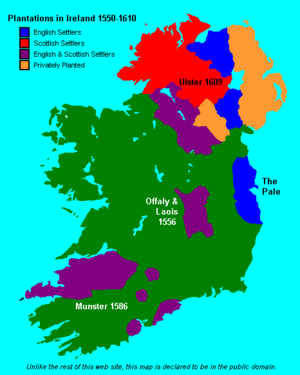
The Plantations of Ireland involved taking land from Irish owners. This land was then given to British settlers. The biggest plantation was in Ulster. This happened after northern Irish lords went into exile in 1607. About 80% of their land went to English-speaking Protestants.
By 1641, many native Irish who still had land were struggling. They often had to sell their estates because of poor management or debts. This loss of status made them willing to join a rebellion, even if it meant risking more.
Many Irish exiles, like Eoghan Ruadh Ó Néill, joined Catholic armies in France and Spain. They became a group of Irish people living abroad who were against the English Protestant rule in Ireland. Back in Ireland, the plantations caused a lot of anger. This anger, along with laws like Poynings' Law (which meant Irish laws needed English approval), helped start the rebellion. The Protestant government often took more land from Catholic landowners.
In the late 1630s, Thomas Wentworth, the main English official in Ireland, planned new plantations. He wanted to increase Protestant control. But King Charles's problems with his opponents in England and Scotland delayed these plans. This meant Catholics still owned over 60% of the land in 1641.
Religious Differences and Unfair Rules
Most wealthy Irish Catholics did not oppose King Charles I ruling Ireland. They just wanted to be treated fairly and keep their important place in Irish society. But their religion prevented this. They also faced the constant threat of losing their land. The failed Gunpowder Plot of 1605 led to more discrimination against Catholics.
The Protestant Church of Ireland was the only approved church. However, it was a minority even among Irish Protestants. Both Protestants and the majority Catholic population had to pay taxes to this church. This caused great anger. Practicing Catholicism in public could lead to arrest. Not attending Protestant services meant paying fines. Catholics could not hold high government jobs or serve above a certain rank in the army. The Irish government was controlled by English Protestants. The Irish Parliament also had a Protestant majority.
In response, Irish Catholic leaders asked King James I and later King Charles for full rights and religious freedom. They seemed to reach agreements several times. In exchange for more taxes, their demands would be met. But despite paying more taxes after 1630, Charles delayed fulfilling his promises. He finally instructed officials to publish the necessary laws on May 3, 1641.
Wentworth, the main English official, often stopped these promises from being kept. He checked land titles to raise money. He took and planned to settle lands in counties Roscommon and Sligo. He also planned more plantations in counties Galway and Kilkenny. These plans mostly targeted Anglo-Irish Catholic families. Historians believe he would have faced armed resistance if he had continued these policies. However, the actual rebellion happened after English and Scottish politics became unstable. This weakened the king's position in 1640. Wentworth was executed in London in May 1641.
The Secret Plan
From 1638 to 1640, Scotland rebelled against King Charles I. This was known as the Bishops' Wars. Charles tried to make the Scottish church more like the Church of England. The Scottish people thought this was too close to Catholicism. The King's attempts to stop the rebellion failed. The English Parliament, which had similar religious concerns, refused to approve new taxes for an army.
So, Charles began talking with Irish Catholic nobles. He wanted to recruit an Irish army to fight in Scotland. In return, he would grant their requests for religious freedom and land security. This army, mostly Irish Catholics from Ulster, began to form. But it started to break up in mid-1641. To the Scots and English Parliament, this seemed to prove Charles was a tyrant. They thought he wanted to force his religious views on his kingdoms.
In early 1641, some Scots and English Parliament members even suggested invading Ireland. They wanted to control Catholics there. This would stop any royalist Irish Catholic army from landing in England or Scotland.
Frightened by this, a small group of Irish Catholic landed gentry decided to act. Some were even members of Parliament. They planned a quick takeover of Dublin Castle and other important towns. They would do this in the King's name. Their goals were to prevent an invasion and force the King to meet Catholic demands. At least three Irish army officers were involved. The plotters hoped to use soldiers from the breaking-up Irish army.
Economic Hardship
Bad economic conditions also helped cause the rebellion. The Irish economy was in a recession. The harvest in 1641 was poor. Interest rates in the 1630s were very high, sometimes 30% per year. Leaders of the rebellion, like Phelim O'Neill and Rory O'Moore, were deeply in debt. They risked losing their lands to people they owed money to.
Irish farmers were also hit hard by the bad harvest. They faced rising rents. This made them want to remove the settlers. It also led to widespread attacks on settlers at the start of the rebellion. One of O'Neill's creditors was killed early in the rebellion.
The Rebellion Begins
The rebellion was planned by a small group of Catholic nobles and military officers. Many were Gaelic Irish from Ulster who had lost land and power. The plan was to start on Saturday, October 23, 1641. Armed men, led by Connor Maguire and Rory O'Moore, were to seize Dublin Castle. They would hold it until other rebels arrived. Meanwhile, Felim O'Neill and his allies would take important places in Ulster.
The English army in Ireland was small, about 2,000 soldiers. They were spread out across the country. The plot relied on surprise. Once they took control, they would announce their demands. They expected support from the rest of the country.
The plan to take Dublin Castle failed. One of the leaders, Hugh Og MacMahon, told his foster-brother, a Protestant. This person quickly told one of the English officials. MacMahon and Maguire were arrested. The other plotters escaped Dublin. Warnings about the uprising had also reached Dublin.
Despite this failure, the rebellion in Ulster went ahead. Felim O'Neill and his allies, including Rory Maguire, quickly captured many places. These included Dungannon, Charlemont Fort, Newry, Tandragee, Portadown, Mountjoy Castle, Castleblaney, and Carrickmacross. Places that did not surrender, like Enniskillen Castle, were surrounded. Within two days, the rebels held most of counties Armagh, Tyrone, Fermanagh, and Monaghan.
O'Neill issued the Proclamation of Dungannon on October 24. It said they had taken up arms only to defend their freedoms. It also claimed they meant no harm to the king's subjects. On November 4, the Newry declaration followed. It falsely claimed King Charles had approved the uprising to protect Ireland from his opponents in England.
Even though the declaration was fake, many Anglo-Catholic nobles were upset. The Dublin government had taken harsh actions against Catholics. This included those who had first condemned the rebellion. The Irish Parliament was suspended on November 17. This took away their way to solve problems peacefully. The fake declaration gave moderate Catholics a reason to join the rebels. Rumors also spread that radical Protestants wanted to replace King Charles I. This would lead to more oppression of Irish Catholics.
The powerful Lords of the Pale joined the uprising in early December. Rebels in Cavan were led by Philip O'Reilly, a local Member of Parliament. Dundalk was taken. An army under Brian McMahon moved south towards Dublin. On November 21, they surrounded Drogheda from the north. Other rebels advanced through County Meath. They blocked Drogheda from the south. Then, on November 29, they defeated an English army sent from Dublin at Julianstown. Over 600 English soldiers were killed.
On November 28, about 8,000 rebels surrounded Lisnagarvey. But they lost about 300 men in a failed attack. They then set fire to the town and retreated. This setback showed the rebels that a quick victory in Ulster would not be easy.
Further south, the rebellion spread to counties Leitrim, Longford, Wicklow, Wexford, Tipperary, and Kildare. The Dublin government called it a "disloyal and terrible conspiracy" by "evil Irish Catholics." They claimed it aimed at "a general killing of all English and Protestant inhabitants."
In December, troops led by Charles Coote and William St Leger attacked rebel areas. These attacks were known for "extreme and widespread brutality" against Catholic people. This caused many to join the rebellion. This included people in previously peaceful Munster, where St Leger had imposed harsh military rule.
Violence in Ulster
When the rebellion began, Phelim O'Neill tried to get Scottish settlers on his side. He offered them protection, hoping they would support him. This helped the revolt spread quickly at first. The Dublin government was unsure who to trust, so they were slow to respond.
The situation changed when it became clear the uprising was only partly successful. The breakdown of government control led to widespread attacks by Catholic farmers on Protestants, no matter their nationality. Soon, some nobles joined in. O'Neill's power was mostly limited to County Armagh, and even there, it wasn't complete. His own brother was involved in these attacks.
A Catholic writer at the time said O'Neill "tried to stop the common people from frequent savage actions of stripping and killing." But once the violence started, "the lower sort of people could not be controlled." Some argue the initial attacks were for economic reasons. Killings happened only when victims fought back. The violence grew, especially in Ulster, where many had lost land in the plantations. Attacks on Protestant church leaders were partly due to anger at the wealth of the Church of Ireland there. Other reasons included religion and culture. In County Cavan, rebels said the uprising was to protect the Catholic religion. They brought back original Irish language place names and banned English.
After their defeat at Lisnagarvey in November, rebels killed about 100 Protestants at Portadown. They forced them off a bridge into the River Bann and shot those who tried to swim. This was one of the bloodiest events of the 1640s. In nearby Kilmore, English and Scottish people were burned to death in a cottage where they were held. In Armagh, about 1,250 people died in the early months. This was about a quarter of the local settler population. In County Tyrone, many British families were killed near Kinard. At Shrule in County Mayo, Protestant prisoners were killed by their Catholic guards, even though officers tried to stop it.
Killings of Catholics also happened. About two dozen were killed at Islandmagee by soldiers from Carrickfergus in November 1641. When a Scottish army arrived in Ulster in April 1642, more terrible acts occurred. A historian from the 1800s, William Lecky, wrote that it was unclear which side was more cruel. The Scots executed Irish prisoners near Kilwarlin woods. A soldier named James Turner wrote that after taking back Newry, local Catholics were lined up by the river and killed without a trial. On Rathlin Island, Scottish soldiers were encouraged to kill local Catholic MacDonnells. They threw many MacDonnell women off cliffs to their deaths.
The killings were brought under some control by Owen Roe O'Neill. In July 1642, he took command of Irish forces in Ulster. He hanged several rebels for attacking civilians. After this, the war, though still brutal, was fought more according to military rules.
Pamphlets published in London at the time gave shocking details of the massacres. They claimed over 200,000 Protestants had died. These numbers were known to be greatly exaggerated even then. In November 1641, Parliament jailed a publisher who admitted paying for fake stories. Recent studies suggest about 4,000 were killed in the attacks. Thousands more were forced from their homes. Many of these died from cold or sickness. This leads to an estimate of about 12,000 deaths in total. This is about 10% of all settlers in Ireland. In Ulster, the percentage of deaths was higher, around 30%.
These events were used to claim the rebellion was a Catholic plot to wipe out all Protestants. This story was built from the Depositions. These were reports from victims collected between 1642 and 1655. In 1646, these accounts were summarized in a book called The Irish Rebellion. The book urged military control of Ireland and separation of Irish Catholics from British Protestants.
In the long run, the 1641 massacres made the hatred between the two groups worse. Modern historians say the killings had a very strong impact on the Protestant community. Dr. Mary O'Dowd wrote they "were very traumatic for the Protestant settler community in Ulster, and left long-term scars." Protestant accounts at the time said the rebellion was a complete surprise. Many argued Catholics could not be trusted. In Ulster, Protestants remembered the anniversary of the rebellion for over two hundred years. This helped them feel united and remember to be watchful against Irish Catholics.
English and Scottish Help Arrives
King Charles, the English Parliament, and the Scottish government all agreed the rebellion must be stopped. But political tensions delayed this. Charles was in Edinburgh when he heard about the uprising on October 28. He immediately asked the Scots to send troops to Ulster. On November 4, Parliament voted to send weapons to Ireland and recruit 8,000 men. But any army would be under the king's control. This made the situation difficult.
There were rumors of royalist military plots in 1641. The rebels also claimed Charles supported their actions. These things increased fears that Charles would use the army against his opponents in England and Scotland, not just the Irish.
The Scottish government urged the English Parliament to pay for a Scottish army. They argued it could reach Ireland more easily and would be independent of Charles and Parliament. Meanwhile, Charles sent some weapons and Scottish volunteers to Ireland. But he did not have enough money for a large army. James Butler, 1st Duke of Ormond, a leader from an important Old English family who had become Protestant, was made commander of royal forces in Ireland. He recruited three army groups from refugees in Dublin. Several important Ulster Scots were also asked to raise troops, including Robert Stewart.
Many politicians in Dublin and London did not want Scottish soldiers in Ulster. They saw a well-armed Scottish army as a threat. Parliament continued to recruit English soldiers. On December 21, the English Lords approved a Scottish army of 10,000. But the Scottish government insisted they also control the three largest ports in Ulster: Carrickfergus, Coleraine, and Derry. They also wanted land grants. The English Commons rejected these demands. This caused more delays and allowed the rebellion to spread.
As the situation worsened, in February 1642, both sides agreed to send 2,500 Scots to Ulster. Parliament then took two important steps. On March 15, the Militia Ordinance put the army under Parliament's control, not the king's. When Charles refused to approve it, Parliament declared the law was in force anyway. This was a big step towards civil war. On March 19, the Adventurers' Act asked people to lend money. This money would be paid back with land taken from the rebels. The need to repay these loans and keep government credit was a reason for the Cromwellian conquest of Ireland in 1649.
In the first few months of 1642, Ormond took back much of the Pale area. He helped Drogheda, recaptured Dundalk, and defeated rebels at Kilrush on April 15. On the same day, the Scottish army led by Robert Monro landed at Carrickfergus. They recaptured Newry on May 1. By mid-1642, Protestant forces in Ireland had 40,000 foot soldiers and 3,600 horsemen. But the start of the First English Civil War in August 1642 stopped more soldiers and money from England. A military standstill followed.
The Founding of the Confederation
By early 1642, there were four main groups of rebel forces. Felim O'Neill led forces in Ulster. Viscount Gormanston led forces in the Pale near Dublin. The Butler family, especially Lord Mountgarret, led forces in the southeast. Donagh MacCarthy, Viscount Muskerry led forces in the southwest. In areas where British settlers were strong, like around Cork, Dublin, Carrickfergus, and Derry, they formed their own local armies. These armies managed to hold off the rebels.
Within a few months, almost all Catholic nobles, including the Anglo-Irish Catholics, joined the rebellion. There were three main reasons for this. First, local lords raised armed groups to control the violence. They feared that after the settlers were gone, the Irish farmers would turn on them. Second, the English Parliament and the Irish government, along with King Charles, made it clear that Irish Catholics who did not show loyalty would be blamed for the rebellion. Their lands would be taken under the Adventurers' Act, agreed on March 19, 1642. The old way of giving pardons to stop conflicts ended. Rebel leaders were declared outlaws on January 1, 1642.
Third, it seemed at first that the rebels would win. They defeated a government army at Julianstown in November 1641. This idea was soon broken when the rebels failed to take Drogheda. But by then, most Catholic nobles had already joined the rebellion. The Catholic nobles around Dublin, called the "Lords of the Pale," sent their complaints to the king on March 17, 1642, at Trim, County Meath.
Hugh O'Reilly (Archbishop of Armagh) held a meeting of Irish bishops at Kells, County Meath in March 1642. Most of them declared that the conflict was a "holy and just war."
On May 10, 1642, Archbishop O'Reilly called another meeting in Kilkenny. Three archbishops, 11 bishops, and other important people were there. They wrote the Confederate Oath of Association. They asked all Catholics in Ireland to take it. Those who took the oath promised loyalty to Charles I. They also promised to obey all orders from the "Supreme Council of the Confederate Catholics." From then on, the rebels were known as Confederates. The meeting confirmed that the rebellion was a "just war." It called for a council (of church leaders and nobles) for each province. A national council would oversee these. It promised to punish bad actions by Confederate soldiers. It also said any Catholic who fought against the Confederation would be removed from the church. The meeting sent people to France, Spain, and Italy. They hoped to get support, money, weapons, and recruit Irish soldiers serving abroad.
Lord Mountgarret was chosen as president of the Confederate Council. A General Assembly was held in Kilkenny on October 24, 1642. It set up a temporary government. Fourteen Lords Temporal and 11 Lords Spiritual from the Irish Parliament were there, along with 226 commoners. The Assembly chose a Supreme Council of 24 members. This council controlled both military and civilian leaders. Their first act was to name the generals for the Confederate forces. Owen Roe O'Neill would lead the Ulster forces. Thomas Preston would lead the Leinster forces. Garret Barry would lead the Munster forces. John Burke would lead the Connaught forces. A national treasury, a place to make coins, and a printing press were set up in Kilkenny.
The Confederation eventually joined forces with the Royalists. In return, they were promised self-government and full rights for Catholics after the war. But they were finally defeated by the English Parliament's New Model Army from 1649 to 1653. After this, land ownership in Ireland mostly went to Protestant settlers.
Images for kids
See also
- Chronology of the Wars of the Three Kingdoms
- Cromwellian conquest of Ireland
- List of Irish rebellions


